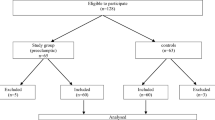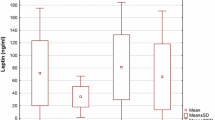Abstract
Purpose
To assess maternal leptin levels as a marker for preeclampsia (PE) and to explore the possibility of leptin being a marker of severity of preeclampsia.
Participants and methods
Comparative prospective study was conducted among a total of 72 pregnant women at 28–38 weeks of gestation. They were divided into two groups (control and study) according to the absence or presence of clinical parameters of preeclampsia. Leptin was measured for both groups at the time of presentation, once weekly and at the termination of pregnancy.
Results
Leptin levels were found to be significantly higher among all preeclampsia patients when compared to the control group; whether at admission or at the time of delivery. Mean serum leptin level at admission in control group was 9.8 ng/ml versus 10.9 ng/ml in mild cases and 17.6 ng/ml in severe cases. At the time of delivery, mean serum leptin in control group decreased to 4.7 ng/ml while in preeclampsia patients it increased up to 22 ng/ml in mild cases and 42.6 ng/ml in severe cases. ROC curve analysis has shown that a cut off value >13.7 ng/ml can be used to detect presence of preeclampsia with a sensitivity of 91 % and specificity 100 % while a cut off value >22.5 ng/ml can be used to detect severity of preeclampsia with a sensitivity of 85 % and specificity 100 %.
Conclusion
Maternal serum leptin is significantly elevated in preeclampsia, also it can be used as a marker for the presence of preeclampsia and to differentiate patients with mild preeclampsia from those with severe disease.


Similar content being viewed by others
References
Noris M, Perico N, Remuzzi G (2005) Mechanism of disease pre-eclampsia. Nat Clin Pract Nephrol 1(2):98–114
Burrow GN, Duffy TP (2009) Medical complications during pregnancy, 5th edn. WB Saunders, Philadelphia, p 53
Lonnqvist F, Nordfors L, Jasson M, Torne A, Schalling M, Arner P (1997) Leptin secretion from adipose tissue in women relationship to plasma levels and gene expression. J Clin Invest 99:398–404
Clement K, Vaisse C, Lahiou N (1998) A mutation in the human leptin receptor gene causes obesity and pituitary dysfunction. Nature 392:398–401
Bouloumie A, Garmendia JV, Bianco NE, Sanctis JB (2001) Antihypertensive treatment decreased serum leptin levels in severe preeclampsia during pregnancy. Ann Nutr Metab 45(5):190–192
Anim-Nymae N, Sooranne SR, Steer PJ, Jonson MR (2000) Longitudinal analysis of maternal plasma leptin concentrations during normal pregnancy and pre-eclampsia. Hum Reprod 15(9):2033–2036
Mantzoros S, Varvarigou A, Kaklamani VG, Beratis NG, Filer JS (1997) Effects of birth weight and maternal smoking on cord blood leptin concentrations of full-term and preterm newborns. J Clin Endocrinol Metab 82:2856–2861
Hassink SG, Sheslow DV, De Lancey E, Opentanova I, Considine RV, Cro JF (1997) Serum leptin in children with obesity. Relationship to gender and development. Pediatrics 98:201–203
Louh SM, Di Marco F, Levin N, Armaninikv M, Xie MH, Nelson C, Bennett Gl, Williams M, Spensor SA, Gurney A, De Sauvage FJ (1997) Cloning and characterization of a human leptin receptor using a biologically active leptin immunoadhesion. J Mol Endocrinol 18:77–85
Yura S, Itoh H, Sagawa N, Yamamoto H, Masuzaki H, Nakao K, Kawamura M, Takemura M, Kakui K, Ogawa Y, Fuji S (2005) Role of premature leptin surge in obesity resulting from intrauterine undernutrition. Cell Metab 1:371–378
Campbell S, Pearce JM, Hakett G (1986) Qualitative assessment of uteroplacental blood flow: early screening test for high risk pregnancies. Obstet Gynecol 6:649
Cheab FF, Mounzih K, Lu R, Lim ME (1997) Early onset reproductive function in normal female mice treated with leptin. Science 275:88–90
Butte NF, Hopkinson JM, Nicolson MA (1997) Leptin in human reproduction: serum leptin levels in pregnant and lactating woman. J Clin Endocrinol Metab 82:585–589
Teppa RJ, Ness RB, Crombleholme WR, Roberts JM (2000) Free leptin is increased in normal pregnancy and further increased in preeclampsia. Metabolism 69(8):1043–1048
Iftikhar U, Khoja A, Mehjabeen, Iqbal A, Karira KA (2008) Evaluation of serum leptin levels during normal pregnancy and preeclampsia. J Ayub Med Coll Abbottabad 20(4):137–140
Lachin JM (1998) Introduction to sample size determination and power analysis for clinical trials. Control Clin Trials 2:93–113
Ramsay JE, Jamieson N, Greer IA, Sattar N (2003) Paradoxical elevation in adiponectin concentrations in women with pre-eclampsia. Hypertension 42:891–894
Sucak A, Kanat-Pektas M, Gungor T, Mollamahmutoglu L (2010) Leptin levels and antihypertensive treatment in preeclampsia. Singapore Med J 51(1):39
Vitoratos N, Chrystodoulacos G, Salamalekis E, Kassanos D, Kouskouni E, Creatsas G (2002) Fetoplacental leptin levels and their relation to birth weight and insulin in gestational diabetic pregnant women. J Obstet Gynaecol 22:29–33
Hendler I, Blackwell SC, Mehta SH (2005) The levels of leptin, adiponectin, and resistin in normal weight, overweight, and obese pregnant women with and without preeclampsia. Am J Obstet Gynecol 193:979–983
Batha JL, Romero-Carmona R, Escobar-Liompart M, Comino-Delgado R (2001) The relationship between leptin and inflammatory cytokines in women with preeclampsia. BJOG 108:1272–1276
Mumtaz F, Memon AR, Yousfani S, Tahir SM, Khushk I, Memon M, Memon A (2008) Role of serum leptin as a marker of severity of preeclampsia. J Ayub Med Coll Abbottabad 20(1):13–15
Teppa RJ, Ness RB, Cromblehome WR, Roberts JM (2000) Free leptin is increased in normal pregnancy and further increased in preeclampsia. Metabolism 8:1043–1048
Acromite M, Zitopoulou M, Orolova C, Mantzorous C (2004) Increased leptin levels in preeclampsia: associations with BMI, estrogen, SHBG levels. Hormones 3(1):46–52
Martínez-Abundis E, González-Ortiz M, Pascoe-González S (2000) Serum leptin levels and the severity of preeclampsia. Arch Gynecol Obstet 264:71–73
Asnafi N, Sharbatdaran M, Hajian K (2011) Comparison of maternal and neonatal serum leptin levels in preeclampsia and normal pregnancy. Iran J Reprod Med 9(2):131–134
Kim MH, Cho YK, Ko JK, Kang WS, Park KH, Lee CM, Choi H, Kim BR, Lee HK (2003) Study on umbilical cord plasma leptin in preeclamptic and normal pregnant women. Korean J Obstet Gynecol 46(12):2366–2372
Conflict of interest
The authors report no declaration of interest.
Author information
Authors and Affiliations
Corresponding author
Rights and permissions
About this article
Cite this article
El shahat, A.M., Ahmed, A.B., Ahmed, M.R. et al. Maternal serum leptin as a marker of preeclampsia. Arch Gynecol Obstet 288, 1317–1322 (2013). https://doi.org/10.1007/s00404-013-2915-8
Received:
Accepted:
Published:
Issue Date:
DOI: https://doi.org/10.1007/s00404-013-2915-8




